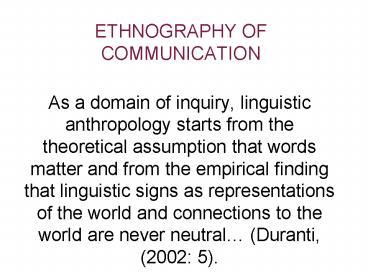ETHNOGRAPHY OF COMMUNICATION - PowerPoint PPT Presentation
1 / 23
Title:
ETHNOGRAPHY OF COMMUNICATION
Description:
Do you think Hip Hop music can be considered a marker of personal or/and group identity? ... Videos: 'American Tongues' and 'Urban Chronicle' Form. 1. 5 ... – PowerPoint PPT presentation
Number of Views:1891
Avg rating:3.0/5.0
Title: ETHNOGRAPHY OF COMMUNICATION
1
ETHNOGRAPHY OF COMMUNICATION
- As a domain of inquiry, linguistic anthropology
starts from the theoretical assumption that words
matter and from the empirical finding that
linguistic signs as representations of the world
and connections to the world are never neutral
(Duranti, (2002 5).
2
Discussion Questions (Video)
- 1. Can Urban Franco Hip Hop music be considered
part of a linguistic community in Montreal?
3
How is this type of music, in the context of
Montreal, articulated in terms of race, ethnicity
or age?
4
Do you think Hip Hop music can be considered a
marker of personal or/and group identity? How?
Why?
5
Sociolinguistics and Linguistic Anthropology
- Connected to sociology
- Quantitative methods
- Urban environments
- Developed in the 1950s and 60s
- Subfield of Anthropology
- Qualitative methods
- Small scale societies
- Developed by Frank Boas (early 1900s)
6
Influenced by Ethnography of Communication
- Dell Hymes (1960s and 1970s)
- Linguistics in the widest possible way folklore,
international linguistics, cognitive
anthropology, sociology, etc
7
Ethnography of communication The study of
communication in its widest cultural and social
context, including rules of language, norms of
appropriate language use in particular settings,
and evaluations given by members of a culture to
various speech styles
8
Concern with
- Segmentation of a speech communities class,
gender, race, age, and ethnicity - Alternative means utilised by speakers to obtain
goals - The roles of speakers as social actors
- The function of speaking as a social activity
9
Speech event and Context
- Would you be so kind as to pass me the salt?
- Gimme the salt!
- Many ways to achieve several purposes
10
Communicative rules
- Exist in all cultures
- Define acceptable behavior
- Give directives
- shape behaviour and help in evaluating others
- May change from context to context
- Cultural specific
11
The most important aspects of a communicative
interaction are
- Settings
- Participants
- topics
- Goals
- They are interconnected
- Two types of communicative interactions formal
and informal
12
Formal University Class
- Setting a fixed arranged local, A university
classroom - Participants are defined students and teachers
- Topics fixed math, history, anthropology, etc
- Goals to teach and learn, etc.
13
Setting
- Arena for action
- Define events
- Culturally defined formalities
14
Universal Aspects of Formality (Irvine, 1979)
- Increased structuring rules of etiquette
- Consistency of co-occurrence choices stylistic
choices - Emphasis on positional identities of
participants play of multiple roles or
identities - Emergence of a central situational focus
constrains on choice of topic
15
Participants
- Speakers, addressees, and audiences
- Choice of speakers
- --pronunciation
- --prosodic features
- --syntax
- --choice of words
- --nonverbal cues
16
Terms of address
- FN,
- Title Last name (TLN)
- Reciprocal FN and TLN
- Non-reciprocal FN-TLN and TLN-FN
- Pronouns T and V from the French Tu and Vous
- Honorifics markers that signal respect
17
Nahuatl degrees of respect
- I. intimacy and subordination prefixes between
intimates of similar age and status to signify
closeness - II. Neutrality and distance prefixes employ
among strangers - III Honour to address older woman and men
- IV Restricted to people who are in a compadrazgo
relationship
18
TOPICS and GOALS
- TOPICS
- Preference of co-participants
- Disapproval of violations of rules
- GOALS
- Individual and collective
- Expressed in a variety of forms
- Formal or informal language
19
Exam Review
- content and form
20
Exam Review1.content overview2. Form and
content of exam
21
Content Overview
- Types of meanings transmitted through language
situational, cultural and social - Characteristics productivity and displacement
- Formal Properties of Language sounds,
vocabulary and grammar a) Grammar morphology
and syntax - 1. Morphological analysis morphemes
(stems and affixes) - 2. Nonverbal Communication a. kinesics and
proxemics - B. Extended and Transferred Meaning
- 1. metaphor and metonymy
22
Content Overview (2nd)
- 1. Language and cultural meaning a) Cultural
models - 2. Foundation of Linguistic anthropology
- Ethnography of communication(Dell Hymes)
- 1. Aspects of Communicative Interaction. a)
setting, particip, topics, goals 1. Formal and
informal .
23
Content and Form of Exam One
- Content
- Will cover
- Bonvillain Chapters 2 and 4 Martin and Nakayama
Chapters 4 and 6 langers language and
Thought, Roberts A Brief history of English,
Hoffmans Life in a New Language - Videos American Tongues and Urban Chronicle
- Form1. 5 multiple choice questions (5 marks)
- 2. 5 definitions ( 5 marks)
- 3. 3 short answers (with examples) (6 marks)
- 4. 1 essay type question out of two (9 marks)

